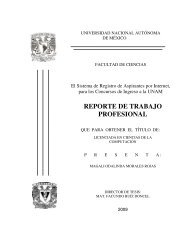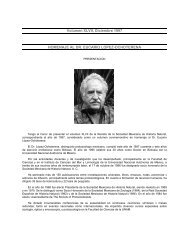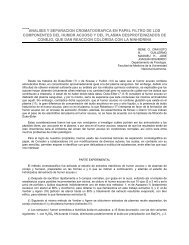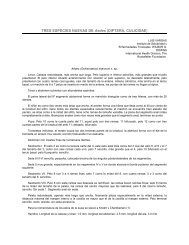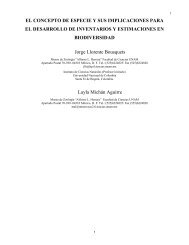With regard to various parasitic (better, symbiotic) protozoa, however, few that were representative of the majorgroups of such forms known today had been seen by the earliest pioneers in <strong>de</strong>scriptive protozoology (seepreceding pages). Thus major "firsts" in this great area are worthy of consi<strong>de</strong>ring next. Than we shall return to thesubject of advances involving mostly the taxa of free-living protozoa protists.DISCOVERIES INVOLVING PARASITIC PROTOZOAThe single period 1835-1850 seems to have been a rich one with respect to discoveries of importantparasitic/symbiotic forms, although several such findings had already been ma<strong>de</strong> by either Leeuwenhoek or Müller inpreceding centuries (as will be noted below). Purkinje and Valentin (1835) saw and named Opalina (recall that ourrespected friend from Delft had surely seen opalinids sensu <strong>la</strong>to and had drawn a specimen of the closely re<strong>la</strong>tedCepe<strong>de</strong>a); and Hake (1839) published an account on Eimeria from the rabbit (but an oocyst of this coccidian hadalso been observed by Leeuwenhoek). Donné (1836), a physician, discovered the parasitic Trichomonas vaginalis inone of his female patients (but both Leeuwenhoek and O.F.M. had seen members of this or re<strong>la</strong>ted genera). Grubyand De<strong>la</strong>fond (1843) <strong>de</strong>tected ophryoscolecid ciliates in the stomach of a rumiant. Gruby (1843), again, and Gluge(1842) and Mayer (1843) --and perhaps others at about the same time-- observed trypanosomes from cold-bloo<strong>de</strong>dvertebrate hosts, and Gruby was the one to create the generic name Trypanosoma; it would not be for another 35-40years before mammalian trypanosomes were fully recognized and studied (see below).Miescher (1843) is credited with <strong>de</strong>scription of the first sarcosporidian, found in the muscle of a mouse. Kölliker(1848) and Stein (1848), in the same year, ma<strong>de</strong> observations on gregarine sporozoa; but Dufour (1828) hadalready discovered gregarines from a beetle, 20 years before, in perhaps the first full account of protozoa livingwithin the body of another organism. Leidy (1849), the earliest North American protozoologist of great stature,<strong>de</strong>scribed the first "true" Nyctotherus, a species from the cockroach (Leeuwenhoek's ciliate from the frog was surelya Nyctotheroi<strong>de</strong>s). Finally, in this rich period of discoveries in the area of parasitic protozoology during the first half ofthe productive 19th century, mention must be ma<strong>de</strong> of Gros (1849) who, working in Russia, was the first discovererof amoeba living in humans. He studied Entamoeba gingivalis from the mouth; it was not until 26 years <strong>la</strong>ter that thepathogenic intestinal amoeba, Entamoeba histolytica, was <strong>de</strong>tected by Lösch (1875). Inci<strong>de</strong>ntally, the generic nameEntamoeba was not proposed until near the end of the century, by Casagrandi and Barbagallo (1895).Discoveries of (other) parasitic forms continued into the second half of the past century --and, of course, are stillhappening today, although most mo<strong>de</strong>rn findings are, un<strong>de</strong>rstandably, not such major significance, often being justnew species belonging to already well-established genera. Mention of a few more specific 19th century "firsts" isappropriate here, next. The <strong>de</strong>serving of special attention are the works concerned with what might be termed"medical protozoology", viz., the first studies on the dreadful diseases of human ma<strong>la</strong>ria, trypanosomiasis, andleishmaniasis, afflictions still <strong>la</strong>ying waste to millions of people´s lives every year: so this topic is addressed in theimmediately following section.Davaine (1854) was the first to observe trichomonad f<strong>la</strong>gel<strong>la</strong>tes from the human intestine; and Malmsten (1857)noted the ciliate Ba<strong>la</strong>ntidium from the same general site. The Czech physician Lambl (1859) ma<strong>de</strong> a study of theunique f<strong>la</strong>gel<strong>la</strong>te Giardia from the small intestine; but recall that Leeuwenhoek had <strong>de</strong>tected this organism insamples of his own fecal material, as <strong>de</strong>scribed in a letter of 1681 (see Dobell, 1932, p. 224), more than 175 yearsbefore! Louis Pasteur (1865, 1866) published his famous papers on the microsporidian Nosema bombycis, causativeagent of pébrine disease in the silkworm (the protozoan group genus and species had been named a few yearsearlier, by the phycologist Nägeli, 1857), including practical advice on control and prevention of this otherwiseeconomically disastrous disease. Eimer (1870) ma<strong>de</strong> the earliest extensive investigation of coccidians in varioushosts; and Schnei<strong>de</strong>r (1875), in tribute, gave the name Eimeria to what is still today the principal (except for thema<strong>la</strong>rial P<strong>la</strong>smodium) --and by far the <strong>la</strong>rgest (1000 species!)-- genus among the coccidian sporozoa.EARLY HISTORY OF MAJOR PROTOZOAN TROPICAL DISEASESA fully chronicle on ma<strong>la</strong>riology alone could occupy many volumes; in<strong>de</strong>ed, numerous books have appearedthat treat various aspects of its fascinating story. Here, I must limit my account to a mention of only some of theoutstanding "firsts" associated with that specialized field of <strong>la</strong>rgely medical protozoology. Main sources of the fewdata I present below are to be found in the <strong>de</strong>lightful and long accounts by Garnham (1966, 1971). Goldschmidt(1956), Lechevalier and Solotorovsky (1965), and Manson-Bahr (1963), books --among still others not cited here--that I highly recommend to all ma<strong>la</strong>ria buffs.
By the way, of the five Nobel Prizes awar<strong>de</strong>d in the period 1902-1908 to persons who had worked withmicroorganisms (Louis Pasteur would have been a sixth if he had not passed away before the Prizes wereestablished), four went to researchers concerned at least in part with aspects of ma<strong>la</strong>riology: Laveran, Golgi, Ross,and Koch (the <strong>la</strong>st was the famed German microbiologist, promulgator of Koch's Postu<strong>la</strong>tes, etc., but he did alsowork a bit in parasitic protozoology: e.g., see Koch, 1899). Fritz Schaudinn, who carried out exemp<strong>la</strong>ry research oncoccidians not far removed taxonomically from the haemosporidians and who discovered the causative agent ofsyphilis (Treponema), would certainly have been a seventh Nobel Laureate if he had not died before that <strong>la</strong>stdiscovery of his had been fully recognized and appreciated. And Charles Nicolle, who discovered the exceedinglyimportant re<strong>la</strong>ted parasite Toxop<strong>la</strong>sma in 1908 (see Nicolle and Manceaux, 1908), did become the eighth medicalparasitologist/protozoologist to receive the Nobel Prize (although not until the year 1928). [Additional researchersworking at least in part on "protozoan cells" have since received Nobel Prizes, but usually since the year 1950: somention of their names is generally beyond the scope of the present historical account].Laveran (1880) was the first investigator to see ma<strong>la</strong>rial parasites in human blood, observing the exciting stageof exf<strong>la</strong>gel<strong>la</strong>tion in the formation of microgametes. He also discovered all three major species of the ma<strong>la</strong>rialparasites of humans. He foun<strong>de</strong>d the new field of "comparative haematozoology" and studied other blood-inhabitingmicroorganisms besi<strong>de</strong>s P<strong>la</strong>smodium. Laveran was truly the greatest pioneer in these new and most significantareas of parasitological protozoology.Of many other 19th century workers in the field of ma<strong>la</strong>riology sensu <strong>la</strong>to, I must at least report the stel<strong>la</strong>rcontributions of such investigators as the following three. Danilewsky (1885, and <strong>la</strong>ter), worked on avian and reptilianma<strong>la</strong>rial and was proposer of the taxonomic name Haemosporidia for the whole P<strong>la</strong>smodium group. Golgi (awell-known name in cytology, of course: and it was actually for discoveries in this area that he received --shared withRamon y Cajal-- the Nobel Prize) produced an instant c<strong>la</strong>ssic in research on the human ma<strong>la</strong>rial (Golgi, 1889). AndRoss (1898), ma<strong>de</strong> the break-through discovery of the involvement of mosquitoes, as vectors, in the full life cycle ofthe ma<strong>la</strong>rial. He was working at the time with an avian ma<strong>la</strong>ria, with a Culex vector, but that led immediately torecognition of the role of the female Anopheles mosquito in the human ma<strong>la</strong>rial.Research on the other sporozoan blood parasites (f<strong>la</strong>gel<strong>la</strong>tes) involved are treated next, below) producedobservations relevant to (further) progress in ma<strong>la</strong>riology itself. Three outstanding examples <strong>de</strong>serve special citation:the work by the Roumanian Babes (e.g., 1888), in which the pirop<strong>la</strong>smid Babesia (named in his honor by Starcovici,1893) who were the first discoverers of the transmission of an infectious protozoan disease (babesiosis) by anarthropod vector (the tick): this set the stage for the subsequent uncovering of the role of tsetse flies intrypanosomiases (see below) and of mosquitoes in the ma<strong>la</strong>rial (see above); and that of another American, W.G.MacCallum (1897), who carried out very precise cytological observations on the micro- and macrogametes ofHaemoproteus in birds and, <strong>la</strong>ter of P<strong>la</strong>smodium in humans. Schaudinn, Chagas, von Prowazek, and several othersalso merit recognition here for their unusual contributions just before (or slightly after) the turn of the next century(some of their papers are mentioned in <strong>la</strong>ter sections, below). Many such works --by these men and others-- are tobe found cited in the bibliographies of the references given on ma<strong>la</strong>riology at the beginning of this brief section; andsee Corliss (1978,1979a), too, where one may also find lists of numerous additional names of early workers inLaveran's "haematozoology" sensu <strong>la</strong>to.In the vast parallel area (but also part of Laveran's field) of the trypanosomiases and leishmaniases, caused byf<strong>la</strong>gel<strong>la</strong>te blood parasites in humans and other vertebrates (and also some invertebrates and even a few p<strong>la</strong>nts),reve<strong>la</strong>tions and important advances also occurred towards the end of the 19th and slightly into the 20th century. Atleast seven names stand out historically, listed here very briefly in chronological or<strong>de</strong>r. Lewis (1879, a paperprece<strong>de</strong>d by a couple of preliminary reports elsewhere) first <strong>de</strong>tected Trypanosoma lewisi (as the species was <strong>la</strong>ternamed) in the blood of rats. Evans (1881, 1882) reported "tryps" from horses. Bruce (1895, 1897) studied othertrypanosomes from domesticated African mammals, and experimentally showed that the tsetse fly was the insectvector involved. Dutton (1902) recognized that one of the African sleeping sicknesses in humans was caused byTrypanosoma gambiense. Donovan (1903) and Leishman (1903) simultaneously discovered that the causativeorganism of ka<strong>la</strong>-azar in India was (what soon came to be named) Leishmania donovani. And, finally, Chagas (1909)<strong>de</strong>scribed the important South American variety of human trypanosomiasis, <strong>la</strong>ter named Chagas' disease: here, thef<strong>la</strong>gel<strong>la</strong>te involved is unique (T. cruzi), the vector is a triatomid bug, and the disease is unlike both the Africansleeping sicknesses and the two main kinds of leishmaniases known in people.With respect to new names or categories proposed for higher level taxonomic units of (mostly) parasiticprotozoa, rather few became avai<strong>la</strong>ble before the 20th century; and some of the ones listed briefly here are now nolonger in vogue. The Sporozoa and the Coccidia are both credited to Leuckart (1879); but the names Gregarina and
- Page 1 and 2: HISTORICALLY IMPORTANT EVENTS, DISC
- Page 4 and 5: aqueous habitats (see the detailed
- Page 8 and 9: Acephalina (for one subgroup of the
- Page 10 and 11: (Elphidium: see above) and by vario
- Page 12 and 13: Vernworn (1889), setting the stage
- Page 14 and 15: esearch, see Foissner, 1987). Sever
- Page 16 and 17: were located at Columbia University
- Page 18 and 19: protozoological research. Pitelka's
- Page 20 and 21: BÜTSCHLI, O., 1876. Studien Über
- Page 22 and 23: CLEVELAND, L.R., 1956. Brief accoun
- Page 24 and 25: DOBELL, C., 1928-1943. Researches o
- Page 26 and 27: Protistenk., 77: 152-174.GELEI, J.
- Page 28 and 29: HERTWIG, R. und E. LESSER, 1874. Ue
- Page 30 and 31: (year 1949): 57-79.KIRBY, H., 1950b
- Page 32 and 33: LEVINE, N.D., 1988. The Protozoan P
- Page 34 and 35: OLIVE, L.S., 1975. The Mycetozoans.
- Page 36 and 37: PUYTORAC, P. de, J. GRAIN, and J.-P
- Page 38 and 39: SONNEBORN, T.M., 1970. Methods in P
- Page 40: WICHTERMAN, R., 1953. The biology o



